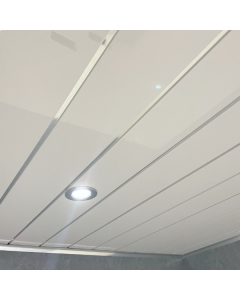
How To Seal A Bath
If your bath seal has deteriorated over the years and you’re wondering how to seal a bath, sealing it yourself couldn’t be easier. It’s one of those jobs that sounds harder than it is and if you’re worried about it looking unprofessional, we have just the trick for you.
A deteriorated bath seal can create crevices for bacteria and mould to grow. It can also let water into parts of your home where it shouldn’t be, resulting in water damage to the walls, floor, electrics and, more worryingly, structural elements of your house. Even a small leak can go unnoticed and, over time, settle in the foundation of the house, encouraging damp.
Here’s how to seal a bath and give it a professional finish using bath trim. Bath trim hides the join between tiled surfaces or wall panels around the bath. It will also cover any imperfections in the silicone you have used to seal where your bath meets the wall.
When you need to consider resealing bath
If your existing bath sealant is beginning to look damaged or as though there is water seeping through, or if it is beginning to look grubby, it’s time to reseal your bath.
What you’ll need for resealing bath
- Silicone sealant
- Bath seal trim
- Masking tape
- Stanley knife
- Sealant finishing tool
How to seal a bath: step-by-step
Check that the area you are about to seal is free from old silicone. If it’s not, remove any old silicone with a putty knife and scrub any remaining silicone with an abrasive pad.
Silicone is a skin irritant so avoid making contact with it by using protective gloves and old clothes.
Step 1
Fill the bath with water. This will weigh the bath down before you start to seal it. It also means you will apply enough silicone for the bath not to pull away from the wall when someone is having a bath.
Step 2
Check that the area you are about to seal is clean and dry. Applying silicone sealant over a wet or damp area can cause mould to grow under the sealed area.
Step 3
Place a strip of masking tape along the wall, just above where you are about to apply the silicone sealant. This will stop the silicone from spreading any further than it needs to go. It will also give the sealant a neat finish.
Step 4
Prepare your bath trim strips by cutting them to the right size using your Stanley knife. Bath trim is our solution for hiding any imperfections in the silicone sealant, so if you feel inexperienced handling silicone, there’s nothing to worry about.
Step 5
Unscrew the nozzle of the sealant tube and cut off the top. Cut the tip of the sealant tube where the nozzle will be slightly larger than the gap where you are resealing bath.
Insert the tube into the cartridge gun and gently squeeze the trigger. Move gradually, applying the sealant along the joint between the bath and the wall. Use the sealant finishing tool to remove any excess sealant and smooth the join.
Step 6
Using the cartridge gun again, apply a strip of silicone sealant to the inside of the cut bath seal trim. Press the strip neatly to the wall and make sure that the two edges fit flush together in the corner of the bath.
Step 7
Wipe away any excess silicone that has been pushed out from beneath the bath seal trim and check for gaps between the trim and the bath or wall. If there are any, you can run a thin bead of silicone sealant into the crevice to further waterproof the seal. Finally, attach end caps to the end of the trim strip to provide a neat finish.
So, that’s how to seal a bath! This process will ensure your resealing bath project will look neat and clean while renewing its waterproofing.
If you’re resealing bath before you install bathroom wall panels or tiles, the process is slightly different and involves using a special clad seal trim kit instead. Take a look at our in depth guide to fitting wall panels for a tutorial on how to install bath trim at the same time as new wall coverings.
How to seal a bath with trim
If your bath has a trim and you feel like it needs to be resealed, you may be wondering how to seal a bath with trim. One of the primary issues with baths with trims is that the seal functions properly when the rubber is pliable, but when this hardens it won’t move with the bath. Should this happen, you can simply seal over the top of the trim with the process detailed above.
Resealing bath with large gaps
If you have a bath that has a large gap to the wall, when wondering how to seal a bath you should try to reposition the bath as close to the wall as possible. If you can’t reposition the bath, apply two beads of silicone next to one another, one on the wall and one on the bath. Then, use a wet finger to blend the two beads together to give you a smooth finish. If the gap is very large, you might need to fit a backer rod to close it and apply the sealant on top.
FAQs
Do you need to fill the bath when resealing bath?
Filling the bath will help to prevent the sealing from cracking when you next take a bath.
How long should you leave a bath after sealing?
Check the instructions on your sealant, but a good rule of thumb is to leave the bath to sit for 48 hours.
Can you put new sealant over old?
You shouldn’t put new sealant over old sealant. The old sealant will likely be mouldy and grubby, so you need to completely remove it rather than cover it up. It’s also not likely that the new sealant can bind properly to the old sealant.


























